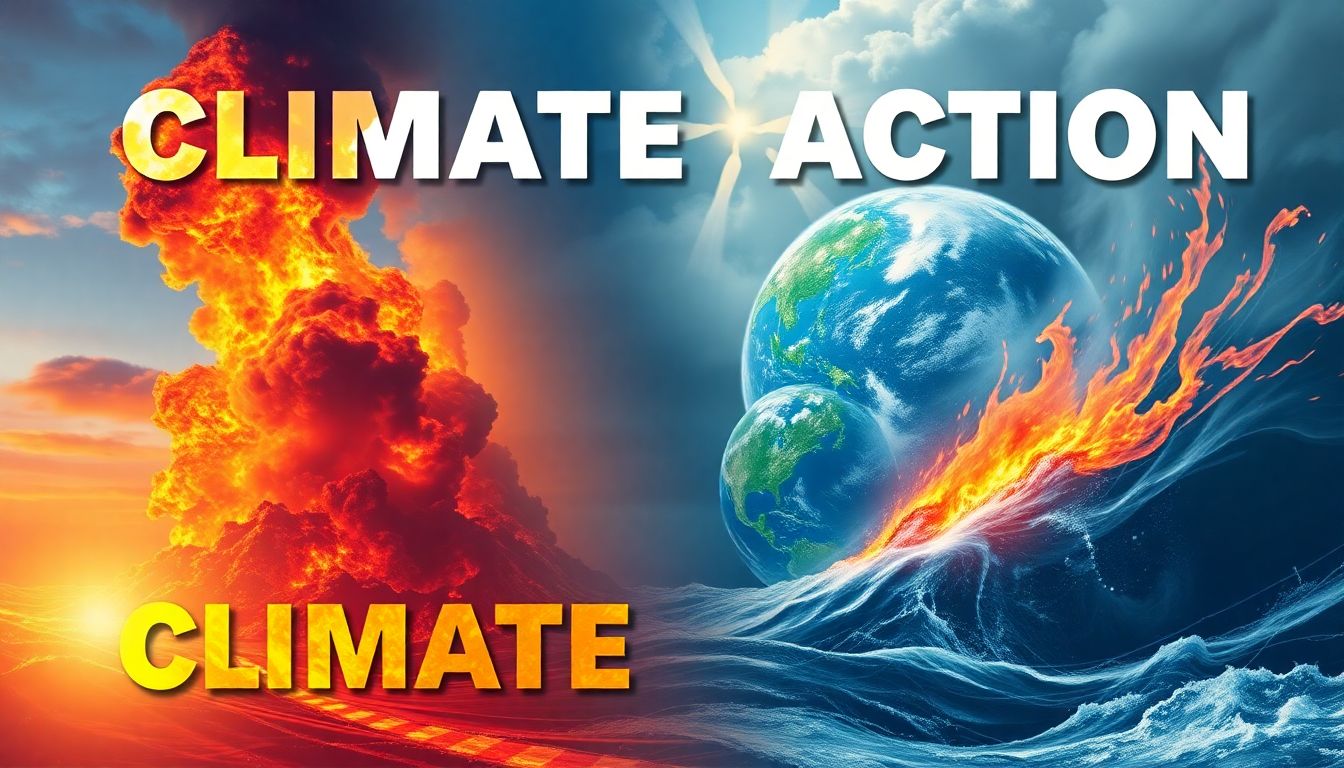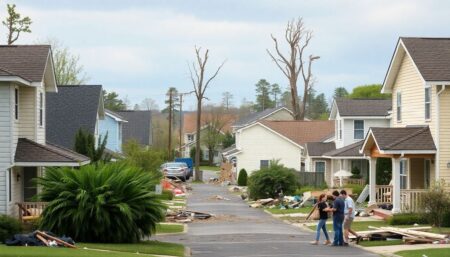Welcome to this insightful exploration of the climate disasters that marked the year 2024. This article delves into the devastating impact of these events, highlighting the financial and human costs, and underscoring the urgent need for global action. Join us as we journey through the data, stories, and expert insights that paint a vivid picture of our changing world.
A Year of Record-Breaking Heat and Devastating Events
Imagine a global map, vivid and interactive, that serves as a stark reminder of the Earth’s climatic turmoil in 2024. This isn’t just a geographical representation; it’s a storyboard of resilience and a call to action.
Peppered across the map, you’ll find icons symbolizing the relentless forces of nature: hurricanes swirling in the Atlantic, typhoons roaring in the Pacific, storms raging across continents, and floods inundating cities. Each icon is a testament to the battles waged and won against the elements.
Overlaying this grim tapestry is a heatmap, a fiery veil that illustrates record-breaking temperatures worldwide. The deepening red hues paint a picture of a world on fire, underscoring the urgent need for collective action against global warming.

The Financial Toll of Climate Disasters
The economic impact of the top 10 climate disasters of 2024 has been nothing short of staggering, with a colossal $229 billion in damages reported worldwide. This alarming figure underscores the increasing financial toll that climate-related events are having on economies around the globe. From devastating hurricanes to relentless wildfires, these disasters have disrupted supply chains, destroyed infrastructure, and left communities reeling in their wake.
What is particularly striking about this data is that three-quarters of the destruction occurred in the United States alone, amounting to a monumental $172 billion. This geographical concentration highlights the vulnerability of the US to extreme weather events, which have become more frequent and intense due to climate change. The economic powerhouse was not immune to the wrath of nature, as various regions faced unprecedented challenges.
A significant aspect of compiling this data is the role of insurance payouts. Insurance companies, which play a crucial part in helping communities recover from disasters, have reported record-breaking payouts. These payouts not only provide a safety net for affected individuals and businesses but also serve as a key indicator of the overall economic impact of these events. By analyzing insurance data, experts can better understand the true cost of climate disasters and work towards more effective risk management strategies.
It is essential to highlight the significance of having two storms, Hurricanes Helene and Milton, each causing over $50 billion in losses. This is a grim milestone that underscores the severity of these events. To put it into perspective, here are the estimated damages:
-
Hurricane Helene:
$55 billion
-
Hurricane Milton:
$52 billion
These storms not only caused immense financial losses but also had profound humanitarian impacts, affecting millions of lives and livelihoods. The frequency and intensity of such events serve as a stark reminder of the urgent need for climate action and better disaster preparedness.

Human Losses and Global Impact
The human cost of recent natural disasters has been devastating, with a staggering total of 2,000 lives lost. This heartbreaking toll is not just a number, but a grim reminder of the families shattered, the communities uprooted, and the futures forever altered. Behind every statistic is a story of loss, courage, and resilience. Let’s delve into the specific events that have contributed to this devastating tally.
In Southeast Asia, Typhoon Yagi swept through with an unrelenting fury, leaving a trail of destruction in its wake. Communities were swallowed by floodwaters, homes were reduced to rubble, and lives were irrevocably changed. The typhoon’s ferocious winds and torrential rains claimed hundreds of lives, making it one of the deadliest storms in recent history. In the aftermath, survivors grappled with the loss of loved ones, the destruction of their homes, and the daunting task of rebuilding their lives.
Meanwhile, in Europe, Storm Boris unleashed its wrath, causing widespread flooding and landslides. Entire villages were submerged, historic landmarks were damaged, and thousands were left without power or shelter. The storm’s fury caught many off guard, leading to a tragic loss of life and a humanitarian crisis that stretched across multiple countries. The sheer scale of the destruction served as a stark reminder of the power of nature and the urgent need for better preparedness and response measures.
Experts have weighed in on the role of climate change in exacerbating these events. According to Dr. Maria Santos, a climate scientist at the University of Madrid, “Climate change is not just a future threat; it’s a present reality. Warmer ocean temperatures fuel more intense storms, and rising sea levels exacerbate flooding.” She emphasizes that without significant reductions in greenhouse gas emissions, these devastating events will become more frequent and severe.
Dr. Andrew Thompson, a meteorologist at the European Centre for Medium-Range Weather Forecasts, adds, “We’re seeing a clear trend towards more extreme weather events. This is not just a matter of chance; it’s a direct consequence of human-induced climate change.”
To mitigate the impact of future disasters, experts call for:
- Increased investment in early warning systems and disaster preparedness.
- Strict implementation of climate policies to reduce greenhouse gas emissions.
- Improved international cooperation to share resources and expertise.

The Science Behind the Disasters
In recent years, the scientific community has made significant strides in linking extreme weather events to human-induced climate change. By employing advanced research methods, scientists can now calculate the increased likelihood of these disasters due to the burning of fossil fuels. One of the primary methods used is attribution science, which combines observational data, climate models, and statistical techniques to quantify the influence of climate change on extreme weather events. This approach allows researchers to compare the probability of an event occurring in the current climate with the probability of it occurring in a world without human-induced greenhouse gas emissions.
A key aspect of attribution science is the use of fraction of attributable risk (FAR) and risk ratio (RR) metrics. FAR represents the proportion of an event’s risk that can be attributed to anthropogenic influence, while RR indicates how much more likely an event is to occur in the current climate compared to a climate without human intervention. For instance, a study published in World Weather Attribution found that the heatwave in Western Europe in 2019 was made up to 100 times more likely due to climate change.
Experts worldwide concur that the fingerprints of climate change are unmistakable in these disasters. Dr. Mariam Zachariah, a renowned climate scientist, notes, “The clear fingerprints of climate change can be seen in the increased frequency and severity of heatwaves, droughts, and heavy rainfall events. The science is unequivocal: human activities, particularly the burning of fossil fuels, are driving these changes.” This consensus is echoed in various reports from the Intergovernmental Panel on Climate Change (IPCC), which emphasizes the role of human activities in altering the Earth’s climate system.
To better understand the link between these disasters and climate change, consider the following points:
- Heatwaves: Studies show that heatwaves have become more frequent and intense. For example, the 2020 Siberian heatwave was deemed virtually impossible without the influence of climate change.
- Droughts: Research indicates that droughts, such as the 2011-2017 California drought, have been exacerbated by higher temperatures and altered precipitation patterns.
- Hurricanes and Typhoons: Warmer ocean temperatures fuel more intense storms, leading to increased rainfall and stronger winds.
- Wildfires: Higher temperatures and drier conditions have extended the wildfire season and increased the severity of fires.

Call to Action: Policy and Compensation
The escalating frequency and intensity of global disasters underscore the urgent need for collective action. From raging wildfires to catastrophic floods, these events are no longer distant threats but immediate realities, devastating communities worldwide. Climate change, driven primarily by human activities, is exacerbating these disasters, making it crystal clear that business as usual is no longer an option. The time for decisive global action is now.
Central to this effort is the critical need to cut emissions. As advocated by Patrick Watt, CEO of Christian Aid, reducing our carbon footprint is not just an environmental issue; it is a moral and economic imperative. Every fraction of a degree matters, as the Intergovernmental Panel on Climate Change (IPCC) reports illustrate the stark differences between a 1.5°C and 2°C world. Transitioning to renewable energy, promoting sustainable practices, and enhancing energy efficiency are essential steps in this direction.
Equally important is the call to increase compensation payments to poor countries. These nations, often the least responsible for historical emissions, are disproportionately affected by climate disasters. Compensation is not charity; it is a matter of climate justice. Wealthier countries, which have benefited from industrialization, have a responsibility to support vulnerable communities in building resilience and adapting to climate impacts. This includes:
- Financial assistance for climate adaptation and mitigation projects.
- Technology transfer to enhance local capacities.
- Strengthening early warning systems and disaster response mechanisms.
Underpinning the severity of these events are political choices that prioritize short-term gains over long-term sustainability. From subsidizing fossil fuels to rolling back environmental protections, these decisions amplify the risks we face. It is high time for leaders to make bold political choices that:
- Prioritize the well-being of people and the planet over corporate interests.
- Invest in green economies that create jobs and promote sustainable growth.
- Foster international cooperation to tackle climate change collectively and effectively.
FAQ
How are the top 10 climate disasters ranked?
What role does climate change play in these disasters?
Why is the US particularly affected?
What are the long-term impacts of these disasters?
What actions can be taken to mitigate future disasters?
- Cutting emissions to reduce the severity and frequency of extreme weather events.
- Increasing compensation payments to poor countries to help them cope with the impacts of climate change.
- Making policy decisions that prioritize renewable energy and global cooperation.









